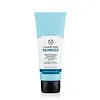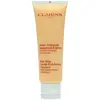What's inside
What's inside
 Key Ingredients
Key Ingredients

 Benefits
Benefits

 Concerns
Concerns

 Ingredients Side-by-side
Ingredients Side-by-side

Water
Skin ConditioningSodium Laureth Sulfate
CleansingOlea Europaea Seed Powder
AbrasiveAcrylates Copolymer
Lauryl Betaine
CleansingGlycerin
HumectantPropanediol
SolventHydrogenated Jojoba Oil
AbrasivePentylene Glycol
Skin ConditioningPhenoxyethanol
PreservativeSodium Chloride
MaskingParfum
MaskingPhenethyl Alcohol
MaskingSodium Hydroxide
BufferingPropylene Glycol
HumectantLuffa Cylindrica Fruit
AbrasiveGlyceryl Caprylate
EmollientFucus Vesiculosus Extract
EmollientDisodium EDTA
Linalool
PerfumingBenzyl Salicylate
PerfumingBenzyl Alcohol
PerfumingCitric Acid
BufferingWater, Sodium Laureth Sulfate, Olea Europaea Seed Powder, Acrylates Copolymer, Lauryl Betaine, Glycerin, Propanediol, Hydrogenated Jojoba Oil, Pentylene Glycol, Phenoxyethanol, Sodium Chloride, Parfum, Phenethyl Alcohol, Sodium Hydroxide, Propylene Glycol, Luffa Cylindrica Fruit, Glyceryl Caprylate, Fucus Vesiculosus Extract, Disodium EDTA, Linalool, Benzyl Salicylate, Benzyl Alcohol, Citric Acid
Water
Skin ConditioningSodium Laureth Sulfate
CleansingCetearyl Alcohol
EmollientCellulose
AbsorbentCocamidopropyl Betaine
CleansingLauramide Mipa
Glycol Distearate
EmollientCetearyl Glucoside
EmulsifyingGlycerin
HumectantAcrylates/C10-30 Alkyl Acrylate Crosspolymer
Emulsion StabilisingTea-Cocoyl Glutamate
CleansingCitrus Aurantium Dulcis Fruit Water
MaskingSilica
AbrasivePersea Gratissima Fruit Butter
EmollientParfum
MaskingPhenoxyisopropanol
PreservativeSodium Chloride
MaskingPropylene Glycol
HumectantSodium Hydroxide
BufferingBenzophenone-2
MaskingButylparaben
MaskingDisodium EDTA
Methylchloroisothiazolinone
PreservativeMoringa Oleifera Seed Extract
Skin ConditioningMethylisothiazolinone
PreservativeChlorphenesin
AntimicrobialEthylparaben
PreservativeMethylparaben
PreservativeBHT
AntioxidantBenzyl Salicylate
PerfumingButylphenyl Methylpropional
PerfumingLimonene
PerfumingLinalool
PerfumingGeraniol
PerfumingCI 15985
Cosmetic ColorantWater, Sodium Laureth Sulfate, Cetearyl Alcohol, Cellulose, Cocamidopropyl Betaine, Lauramide Mipa, Glycol Distearate, Cetearyl Glucoside, Glycerin, Acrylates/C10-30 Alkyl Acrylate Crosspolymer, Tea-Cocoyl Glutamate, Citrus Aurantium Dulcis Fruit Water, Silica, Persea Gratissima Fruit Butter, Parfum, Phenoxyisopropanol, Sodium Chloride, Propylene Glycol, Sodium Hydroxide, Benzophenone-2, Butylparaben, Disodium EDTA, Methylchloroisothiazolinone, Moringa Oleifera Seed Extract, Methylisothiazolinone, Chlorphenesin, Ethylparaben, Methylparaben, BHT, Benzyl Salicylate, Butylphenyl Methylpropional, Limonene, Linalool, Geraniol, CI 15985
 Reviews
Reviews

Ingredients Explained
These ingredients are found in both products.
Ingredients higher up in an ingredient list are typically present in a larger amount.
Benzyl Salicylate is a solvent and fragrance additive. It is an ester of benzyl alcohol and salicylic acid. This ingredient can be naturally found in some plants and plant extracts.
In fragrances, Benzyl Salicylate may be a solvent or a fragrance component. In synthetic musk scents, it is used as a solvent. For floral fragrances such as lilac and jasmine, it is used as a fragrance component. The natural scent of Benzyl Salicylate is described as "lightly-sweet, slightly balsamic".
While Benzyl Salicylate has been associated with contact dermatitis and allergies, emerging studies show it may not be caused by this ingredient alone.
However, this ingredient is often used with fragrances and other components that may cause allergies. It is still listed as a known allergen in the EU. We recommend speaking with a professional if you have concerns.
Another study from 2021 shows Benzyl Salicylate may have anti-inflammatory properties.
Learn more about Benzyl SalicylateDisodium EDTA plays a role in making products more stable by aiding other preservatives.
It is a chelating agent, meaning it neutralizes metal ions that may be found in a product.
Disodium EDTA is a salt of edetic acid and is found to be safe in cosmetic ingredients.
Learn more about Disodium EDTAGlycerin is already naturally found in your skin. It helps moisturize and protect your skin.
A study from 2016 found glycerin to be more effective as a humectant than AHAs and hyaluronic acid.
As a humectant, it helps the skin stay hydrated by pulling moisture to your skin. The low molecular weight of glycerin allows it to pull moisture into the deeper layers of your skin.
Hydrated skin improves your skin barrier; Your skin barrier helps protect against irritants and bacteria.
Glycerin has also been found to have antimicrobial and antiviral properties. Due to these properties, glycerin is often used in wound and burn treatments.
In cosmetics, glycerin is usually derived from plants such as soybean or palm. However, it can also be sourced from animals, such as tallow or animal fat.
This ingredient is organic, colorless, odorless, and non-toxic.
Glycerin is the name for this ingredient in American English. British English uses Glycerol/Glycerine.
Learn more about GlycerinLinalool is a fragrance and helps add scent to products. It's derived from common plants such as cinnamon, mint, citrus, and lavender.
Like Limonene, this ingredient oxidizes when exposed to air. Oxidized linalool can cause allergies and skin sensitivity.
This ingredient has a scent that is floral, spicy tropical, and citrus-like.
Learn more about LinaloolParfum is a catch-all term for an ingredient or more that is used to give a scent to products.
Also called "fragrance", this ingredient can be a blend of hundreds of chemicals or plant oils. This means every product with "fragrance" or "parfum" in the ingredients list is a different mixture.
For instance, Habanolide is a proprietary trade name for a specific aroma chemical. When used as a fragrance ingredient in cosmetics, most aroma chemicals fall under the broad labeling category of “FRAGRANCE” or “PARFUM” according to EU and US regulations.
The term 'parfum' or 'fragrance' is not regulated in many countries. In many cases, it is up to the brand to define this term.
For instance, many brands choose to label themselves as "fragrance-free" because they are not using synthetic fragrances. However, their products may still contain ingredients such as essential oils that are considered a fragrance by INCI standards.
One example is Calendula flower extract. Calendula is an essential oil that still imparts a scent or 'fragrance'.
Depending on the blend, the ingredients in the mixture can cause allergies and sensitivities on the skin. Some ingredients that are known EU allergens include linalool and citronellol.
Parfum can also be used to mask or cover an unpleasant scent.
The bottom line is: not all fragrances/parfum/ingredients are created equally. If you are worried about fragrances, we recommend taking a closer look at an ingredient. And of course, we always recommend speaking with a professional.
Learn more about ParfumPropylene Glycol is an odorless, colorless liquid. As a humectant, it helps skin retain moisture. It also aids in delivering active ingredients.
Another role of this ingredient is preventing a product from melting or freezing. Propylene glycol also adds antimicrobrial properties to a product, elongating product lifespan.
This ingredient is considered an organic alcohol and commonly added into both cosmetics and foods.
Those with sensitive skin or conditions may develop a rash when using this ingredient.
Learn more about Propylene GlycolChances are, you eat sodium chloride every day. Sodium Chloride is also known as table salt.
This ingredient has many purposes in skincare: thickener, emulsifier, and exfoliator.
You'll most likely find this ingredient in cleansers where it is used to create a gel-like texture. As an emulsifier, it also prevents ingredients from separating.
There is much debate on whether this ingredient is comedogenic. The short answer - comedogenic ratings don't tell the whole story. Learn more about comegodenic ratings here.
The concensus about this ingredient causing acne seems to be divided. Research is needed to understand if this ingredient does cause acne.
Scrubs may use salt as the primary exfoliating ingredient.
Learn more about Sodium ChlorideSodium Hydroxide is also known as lye or caustic soda. It is used to adjust the pH of products; many ingredients require a specific pH to be effective.
In small amounts, sodium hydroxide is considered safe to use. However, large amounts may cause chemical burns due to its high alkaline.
Your skin has a natural pH and acid mantle. This acid mantle helps prevent harmful bacteria from breaking through. The acid mantle also helps keep your skin hydrated.
"Alkaline" refers to a high pH level. A low pH level would be considered acidic.
Learn more about Sodium HydroxideSodium Laureth Sulfate (SLES) is a foaming, cleansing, and emulsifying ingredient. It is created from palm kernel oil or coconut oil. SLES is not the same as sodium lauryl sulfate. It is much milder and less likely to irritate.
SLES helps create foam in personal products. It also prevents ingredients from separating, helping to elongate the shelf life.
Sodium Laureth Sulfate is a type of sulfate. It can be drying. We recommend speaking with a professional about using this ingredient if you have concerns.
Learn more about Sodium Laureth SulfateWater. It's the most common cosmetic ingredient of all. You'll usually see it at the top of ingredient lists, meaning that it makes up the largest part of the product.
So why is it so popular? Water most often acts as a solvent - this means that it helps dissolve other ingredients into the formulation.
You'll also recognize water as that liquid we all need to stay alive. If you see this, drink a glass of water. Stay hydrated!
Learn more about Water